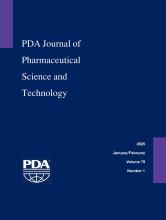Abstract
Pharmacopoeias recognize particulate matter as a common phenomenon. The current regulatory requirements relating to particulate matter in parenterals state that solutions for injections or infusions are clear and practically (or essentially) free from (readily detectable) particles when examined under defined conditions of illumination. Pharmaceutical companies are required to know their processes and have them under control. In order to control and reduce the potential influx of particulate matter, Novartis Technical Operations in Unterach developed a particle life cycle program that involved an establishment of a dedicated particle laboratory operating under clean room conditions. The analytical capabilities of this particle laboratory were crucial for the characterization of particles and supported identification of potential sources of particulate matter. After implementation of this program and respective actions, product and process understanding significantly improved. This resulted in a decrease of reject rates, AQL (Acceptable Quality Limit) failures, and corresponding batch rejections, thereby increasing the availability of Novartis products from Unterach for the patients. The main objective of this article is to show the detailed particle characterization approach including Quality by Design (QbD), methods, and equipment. Examples from projects and particulate matter investigations are presented.
- Microscopic techniques
- Particle laboratory
- Process understanding
- Quality by Design
- Root cause analysis
- Spectroscopic techniques
- Received September 20, 2017.
- Accepted May 22, 2018.
- Copyright © 2018, Parenteral Drug Association
PDA members receive access to all articles published in the current year and previous volume year. Institutional subscribers received access to all content. Log in below to receive access to this article if you are either of these.
If you are neither or you are a PDA member trying to access an article outside of your membership license, then you must purchase access to this article (below). If you do not have a username or password for JPST, you will be required to create an account prior to purchasing.
Full issue PDFs are for PDA members only.
Note to pda.org users
The PDA and PDA bookstore websites (www.pda.org and www.pda.org/bookstore) are separate websites from the PDA JPST website. When you first join PDA, your initial UserID and Password are sent to HighWirePress to create your PDA JPST account. Subsequent UserrID and Password changes required at the PDA websites will not pass on to PDA JPST and vice versa. If you forget your PDA JPST UserID and/or Password, you can request help to retrieve UserID and reset Password below.






